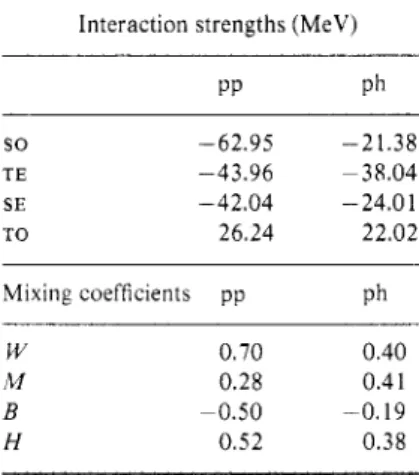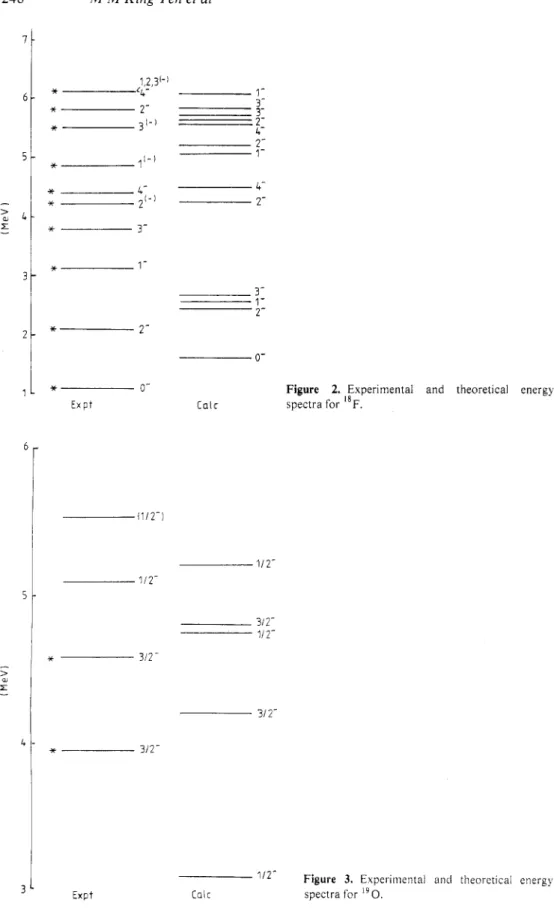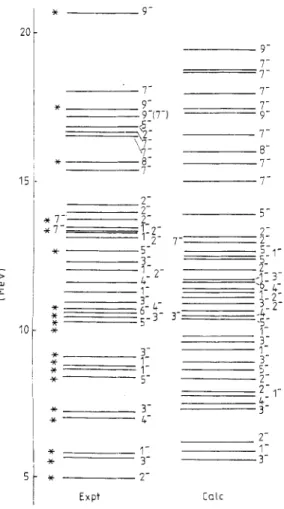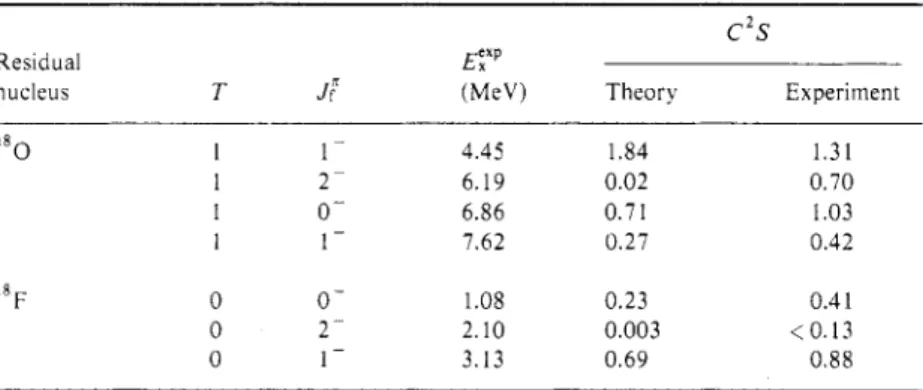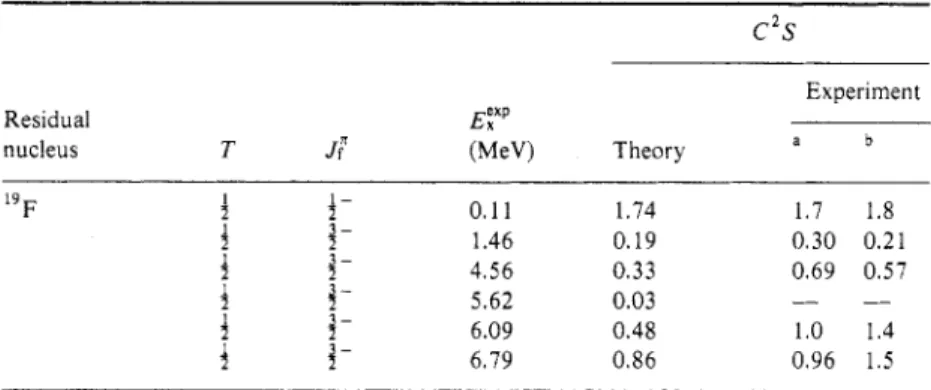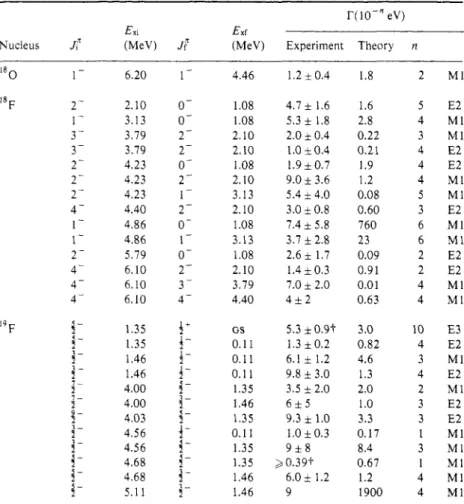This content has been downloaded from IOPscience. Please scroll down to see the full text.
Download details:
IP Address: 140.113.38.11
This content was downloaded on 28/04/2014 at 20:59
Please note that terms and conditions apply.
Shell-model studies of negative-parity states in nuclei with A=18, 19 and 20
View the table of contents for this issue, or go to the journal homepage for more 1982 J. Phys. G: Nucl. Phys. 8 245
(http://iopscience.iop.org/0305-4616/8/2/011)
J. Phys. G : Nucl. Phys. 8 (1982) 245-255. Printed in Great Britain
Shell-model studies of negative-parity states in nuclei with
A
=18,19
and
20f'
M M King Yen$//, S T Hsieh$q, H C Chiang$@ and D S Chuug
$ National Tsing Hua University, Hsin Chu, Taiwan
0 Department of Electrophysics, National Chiao Tung University, Hsin Chu, Taiwan Received 3 1 July 1981, in final form 7 September 1981
Abstract. A shell-model calculation of the negative-parity states in the A = 18, 19 and 20 nuclei is presented. Assuming the nucleus I 6 0 to be the core, an active hole is restricted to the 1 ~ 1 1 2 or 1 ~ 3 1 2 orbits, and active particles are allowed to occupy the l d s p and 2sip orbits. The two-body effective interaction is assumed to be a central potential which has Yukawa radial dependence. The energy spectra are calculated from a least-squares fit to the experimental data, varying the strengths of the exchange interaction and the single-particle level splittings. Spectroscopic factors and E2, E3 and M 1 transition rates are calculated and compared with the observed values.
1. Introduction
It is known that low-lying levels with parity different from the ground state exist in nuclei with A = 18-20. These non-normal parity states can be explained on the basis of excitation of the l60 core. In the last few years several calculations (Arima et a1 1967, Johnstone er a1 1971, McGrory 1970a, b, Benson and Flowers 1969, Elliott and Harvey 1963, Harvey 1964, Ellis and Engeland 1970, 1972, Zuker 1969, McGrory and Wildenthal 1973, Millington er a1 1974, Flores and Moshinsky 1967, Bassichis et a1 1965, Pedersen er a1 1979) on the low-lying negative-parity levels of nuclei with A = 18, 19 and 20 have been performed where the possibility of a core nucleon jumping from the l p shell to the 2s and Id shells is taken into account. Ellis and Engeland (1970) treated the nuclei with A = 16-19 from a weak-coupling-model approach originally suggested by Arima et a1 (1967). For the negative-parity states only 1 h states were considered. Most of the levels fitted favourably with experiment. Zuker (1969) has shown that a weak-coupling model is highly successful in reproducing the energy levels of 18F and The above works showed that the low- lying negative-parity states are predominantly 3p-1 h states.
McGrory and Wildenthal (1973) used a shell-model basis of all Pauli-allowed ( l ~ , , ~ , 2s1/2, ld5,2) configurations outside an inert 12C core to calculate the low-lying positive- and negative-parity states for nuclei with A = 18, 19 and 20. The neglect of the 1p3,2 orbit is the most serious constraint on their model space (Reehal and Wildenthal 1973). The drawback is compensated by including multiparticle excitations from the lpl,2 orbit.
'f Work supported by the National Science Council of the Republic of China. 11 Department of Nuclear Engineering.
Department of Physics.
246 M M King Yen et a1
It is implied from these studies that if the lp3,2 orbit is also taken to be active then considering only one-particle, instead of multiparticle, excitation from the 1 p shell is probably good enough. Furthermore, new experimental information has become available since then. and therefore we believe that it is worthwhile to re-investigate this mass region and to look for a more systematical explanation of odd-parity states.
2. Assumptions
As indicated above, an I6O core is assumed. Only one hole is assumed to be distributed in
the 1p3,2 or 1pll2 orbit and active particles in the Id5,, and 2 ~ , , ~ orbits. The omission of the ld3,2 orbit from the model space is quite naturally based on the previous extensive studies of the problem (Zuker et a1 1968, Reehal and Wildenthal 1973. McGrory 1970a, b. Arima et a1 1968. Halbert et a1 1971). Under these assumptions, the wavefunctions of eigenstates can be written as linear combinations of basis states of the form
y = I j - ' , [d;,Aai T1J1, s'i;zTzJzITdn)m where j = pIl2 or
The Hamiltonian in this space has the form
where H u represents the single-particle energies for 2sIl2, lpl,z and lp3,2 relative to the dj,2 orbit, H,, is the effective interaction between active particles in the ld5,2 and 2sIl2 orbits outside the l60 core and Hph represents the effective interaction between the active particles in the 2s1,2) and the hole in lpl,z or 1 ~ 3 1 2 orbits. McGrory and Wildenthal (1 973) used two different effective residual interactions in their calculation. They found that the results are not dependent on any fine details of the residual interaction. In our calculation, we used the usual central potential of the form
e - r/ro
Vo( W + M P ,
+
BP, - HP,)-
rIru
where W
+
M+
B+
H = 1 and the range parameter ro = 1.4 15 fm. Harmonic os.cillator wavefunctions are used with the oscillator constant v=O.96 fm-', where A = 16. The interaction strengths consist of the T=O, singlet-odd (so) and triplet-even (TE) andT = 1, singlet-even (SE), triplet-odd (TO) components for both pp and ph. These eight interaction strengths and three single-particle energy spacings, i.e. ~(2~1,2-ld5,2).
E( ld5,2-lp1,2) and ~ ( l d ~ , ~ - l p ~ , ~ ) are treated as free parameters in the least-squares fit. For the selection of energy data, in principle we included all the available low-lying states with reliable
J"
assignments up to the point that the first level with an uncertainJ"
assignment appeared. But the high-spin states were all included. The total number of levels used is 54. The overall RMS deviation is 0.45 MeV. The single-particle energy spacings obtained are ~ ( 2 ~ ~ , 2 - l d ~ , 2 ) = 1.35 MeV, c(ld5,2-1p1,2)= 10.35 MeV and ~ ( l d ~ , ~ - l p ~ , ~ ) = 17.47 MeV. which are close to the experimental values of 0.87, 11.52 and 17.82 MeV obtained from data on the nuclei " 0 , I6O and " 0 . The calculated exchange interaction strengths and the coefficients for the relative contributions of the various potentials are listed in table 1. The centre-of-mass spurious-state problem has not been treated in any way here.Shell-model studies of A = 18, 19 and 20 nuclei 24 7
Table 1. The interaction strengths (in MeV) and mixing coefficients. Interaction strengths (MeV)
PP P h so -62.95 -21.38 TE -43.96 -38.04 SE -42.04 -24.01 TO 26.24 22.02 Mixing coefficients pp Ph W M B H 0.70 0.40 0.28 0.4 1 0.52 0.38 0.50 -0.19 3. Results 3.1. Energy levels
The excitation energies of the negative-parity states relative to the ground state were made to fit the observed values. The ground-state energy is defined as
E , = -[EB ( N , 2) - E B ( 160) - ( Z
+
N - 1 6)(E, ("0) - EB (160))]where N and 2 are the total numbers of neutrons and protons in the nucleus. The calculated energy spectra together with observed ones for nuclei with A = 18-20 are shown in figures 1-6. Experimental data are taken from Ajzenberg-Selove (1978) and the recent experimental studies (Mairle et a1 1978, Davis and Abegg 1978, Sens et a1 1977, 1978,
2 - 2 -
*
--*
3-* 1-
~. - 1- Figure 1. Experimental and theoretical energy
248 M M King Yen et ai I 6 5 4 3 2 1 t 5 4 3 1,2,3'-
*
(4-*
2 -*
3 [ - 1 ? [ - I*
2 [ - 1*
*
4-*
3- 1 1- 2- L- 2 - 4- 2- * 1-~-
3- 4 - 2-*
2 -*
0- E x p tFigure 2. Experimental and theoretical energy
spectra for '*F. 1112-1 112- 112- 312- 112-
*
312- 31 2- * 312- E x p tFigure 3. Experiiiicritai and theoretical energy talc spectra for 190.
Shell-model studies of A = 18, I 9 and 20 nuclei 249
*
113/2l- 1312- 312-*
-
:
;
4
*
1112- I1 2-*
312-*
312- 312-*
112- 31 2- 7 / 2 -*
312- 31 2- 31 2 - 112- 312-*
*
112-*
51 2- 512- Y 512-*
-2J7312- --.-.- <I?-*
912-*
I1 2- 3 1 2 -*
31 2-*
512-*
-
112-112- Figure 4. Experimental and theoretical energy E x p t Calc spectra for I9F.
Fortune and Bishop 1977, 1978, Mosley and Fortune 1977, Fortune and Bingham 1977). Levels marked with an asterisk are included in the least-squares fit. Most of the calculated excitation energies agree reasonably well with the data, except for a few levels. In general, the second level for each J is fitted better on average than the yrast level. Those levels for which the discrepancies are larger than 1 MeV are the first excited 3- level at 3.79 MeV for "F, the first excited 2 - level at 4.97 MeV and the first excited 6- level at 10.61 MeV
for "Ne. These discrepancies may be ascribed to our space truncation and the oversimplified effective two-body interaction. Davis and Abegg (1978) measured the tensor analysing power T,, for the reaction 20Ne(d, a ) '*F for E,('*F)<6.48 MeV. They
could not resolve the 6.096 MeV (4-) and 6.108 MeV J = { 1, 2, 3(-)} states; however, their TZ0 extracted for the doublet shows the presence of at least one unnatural parity state. Our calculation predicts a 4; level at 5.56 MeV and a 3; level at 5.83 MeV which can be assigned as the theoretical counterparts of the two levels above. The level at 7.96 MeV for I8O was assigned as a ( 3 + , 4 - ) doublet and our calculated 4- state at 8.08 MeV agrees very well with the observed one.
250 1 i I > r a. I 1 0 M M King Yen et a1 / ( 2 , 3 , 4 1 3, G 13-1
*
2-*
2- 1- 2- 2-*
1- 3- ~- E x p tFigure 5. Experimental and theoretical energy
t a l c spectra for 2 0 ~ .
A
f -
state is known to exist at 5.09 MeV for I9O, but it seems unlikely that the shell- model calculations could miss the first4 -
state by 1.99 MeV. Furthermore, there are two theoretical states remarkably close to the knowni-
state at 5.09 MeV. It was pointed out by Fortune and Bingham (1977) that a simple weak-coupling consideration would imply.x 9-- -9- 1- 1- I 7
*
9 - 9-17-) ~- - 1- 9-3;-
~- 1-\,7'
I
E- * 8 - 1 - 7 - Y 5-- ' 5 - , - 5- 2- -1- 3- -6- I+- 4- 2- 3- &- 1-p-
*
5 - 3 - 3- 4- *-*
.;:
* 3- 1- 3- 3- 1-*
-
1- 5- 2-*
5-* -
* -
,.-
1- 4- * 3- 3- * L- 2-*
1- 1 -*
3- 3- * 2- E x p t ColtFigure 6. Experimental and theoretical energ! spectra for
Shell-model studies of A = 18, 19 arid 20 nuclei 25 1 the existence of several low-lying negative-parity states beginning at about 3-4 MeV. Unless more of the known states are doublets, there is no experimental state corresponding to such a low
i-
state. It was concluded that it was likely that the lowest4-
state remained to be identified. F o r I9F, our calculated levels agree quite well with those' observed experimentally. The levels at 10.69 and 11.53 MeV for "Ne are both assigned a s a ( 3 ? , 4 - ) doublet. Our calculated 4; and 4; states at 10.45 and 11.34 MeV strongly manifest the existence of the negative-parity state in these doublets. The experimental energy spacing between the 2; and 2; states of "Ne is known to be 6.6 MeV, but ourcalculation predicts two 2 - states that d o not have experimental counterparts in this
interval.
To investigate the importance of the inclusion of the lp3/2 orbit, we calculate the intensities of the hole in lpl,2 and lp3,2 orbits. The result shows that the intensity of the lp3,* orbit for the first level of each J is generally around 10% or less. with only two exceptions, i.e. the
4 -
level at 4.00 MeV of I9F and the 1; level at 5.79 MeV of "Ne. F o r these two states. the intensities of the p3,2 orbit are 27% and 35% respectively. F o r the second excited level for each J , the ~ 3 1 2 intensity is in general larger than 20%. This shows that the inclusion of the lp3/2 orbit for l h excitation in this mass region is necessary.In conclusion, the energy spectra for the negative-parity states in the mass region
A = 18-20 can be reproduced reasonably well by considering l h excitation from the 1 ~ , / ~ and lp3/2 orbits. The importance of the 1p3,2 orbit is manifested in the second o r higher excited states for each J .
3.2. Spectroscopic factors
The calculated and observed spectrocopic factors C 2 S of and "F for I = 1 pick-up reactions on 19F are listed in table 2 . T h e ground-state wavefunctions are adopted from
previous calculation (Arima et a1 1967). The theoretical values are in general smaller than the observed ones except for the 1 - level at 4.45 MeV for " 0 . The experimental values
seem too large. F o r example. the maximum theoretical C 2 S values for the 0 - level a t
6.86 MeV of " 0 and the 0 - level at 1.08 MeV and 1- level a t 3.13 MeV of "F are only 0.75, 0.25 and 0.75 respectively. Our calculated C 2 S values for these states are very close to the maximum theoretical values. Therefore there is a very large overlap between our
Table 2. The experimental and theoretical spectroscopic factors of ' * O and l8F for I = 1 pick-up reactions on I9F.
c2s
Residual €:"P
nucleus T J f " (MeV) Theory Experiment
' * O I 1 - 4.45 1.84 1.31 1 2 - 6.19 0.02 0.70 1 0- 6.86 0.7 1 1.03 1 1 - 7.62 0.27 0.42 F 0 0 - 1.08 0.23 0.4 1 0 2- 2.10 0.003 ( 0 . 1 3 0 1 - 3.13 0.69 0.88
The experimental data are taken from Ellis and Engeland (1970, 1972). Ajzenberg-Selove (1978) and Sens et a[(1977. 1978).
252 M M King Yen et a1
Table 3. The experimental and theoretical spectroscopic factors of I9F and 19Ne for I = 1 pick-up reactions on 2oNe.
c2s
Experiment
a b
Residual E Y
nucleus T J ; (MeV) Theory
19F
5
t -
0.11 1.74 1.7 1.8t
3-
1.46 0.19 0.30 0.21i
3-
4.56 0.33 0.69 0.57i
1-
5.62 0.034-
6.09 0.48 1.0 1.4i
4-
6.79 0.86 0.96 1.5_
_
The experimental data are taken from Ajzenberg-Selove (1978) and Fortune and Bingham ( 19 7 7).
a Experimental data for "Ne(t, a)19F. Experimental data for 20Ne(3He, x)"Ne.
wavefunction and the ground-state target wavefunction. Table 3 shows the theoretical and experimental spectroscopic factors of 19F and 19Ne for I = 1 pick-up reactions on "Ne. Two sets of experimental results labelled a and are listed. The column labelled a is the result obtained from the reaction "Ne(t, a)"F and that labelled is obtained from the reaction 20Ne(3He, a)''Ne. The
1-
level at 0.11 MeV for I9F is predominantly a pure p,: state (97%). The excitation energy and the C 2 S value for this state agree very well with theobserved ones. The theoretical CzS values for the other levels selected are somewhat underestimated. The spectroscopic factors obtained for the pick-up reactions "Ne(d, 3He)20F and "Ne(d, t)"Ne are compared with the experimental values (Millington
et a1 1974) in table 4. Clearly, the calculated 1- state at 8.84 MeV and the 3- states at 10.39 and 10.88 MeV agree with the observed ones reasonably well. These three levels contain a significant p,: component with intensity 36.7%, 17.8% and 26.9% respectively.
In conclusion, the overall results show that the calculated spectroscopic factors are, in general, slightly smaller than the experimental observations.
Table 4. The experimental and theoretical spectroscopic factors of "F and 2oNe for i= 1 pick-up reactions on 21Ne.
~ ~ ~~
c2s
Residual E?*
nucleus T Jf" (MeV) Theory Experiment
2o F 1 1 1 Ne 0 0 0 0 0 20 1- 0.98 2- 1.3 1 2- 1.84 3 - 5.62 1- 5.79 1 - 8.84 3 - 10.39 3- 10.88 0.96 0.48 1.14 0.002 0.005 0.30 0.06 0.11 0.84 0.86 0.69 0.02 0.03 0.33 0.08 0.13 ~
The experimental data are taken from Millington et a1 (1974), Ajzenberg-Selove (1978). Fortune and Bishop (1977) and Mosley and Fortune (1977).
Shell-model studies of A = 18, 19 and 20 nuclei 253
3.3. E M transition rates
We calculated E2, E3 and M1 transition rates to provide a more sensitive test of the
wavefunctions. The reason that the E l transition rates are left out is because the spurious states due to the motion of the centre of mass are not removed in our calculation. The radial integrals are evaluated between harmonic oscillator wavefunctions with hw =
14.0 MeV (Hsieh et a1 1975). The reduced width
r
is very sensitive to the y-ray energies. In actual calculation, we used the experimental values for the y-ray energies. For electric multipole transitions effective charges of ep = 1.5 and e, =0.5 are assumed. For M1 transitions, the free gyromagnetic factors are used.Table 5 shows the calculated and experimental E M transition rates. The calculated results are in reasonably good agreement for most of the transitions. The 4; -+ 3; M1 transition for "F and the 3;
+Obs
E3 transition for 20Ne are too small compared with the observed values. This may be due to the neglect of the octupole vibration. However, only small changes in the amplitudes may improve the results.Most of the M1 transitions agree reasonably well with the observed ones. In general, our calculated M 1 transition rates are slightly smaller than the experimental data. This defect may be improved if the effective magnetic moment is taken into account.
Table 5 . The experimental and theoretical E M transition rates for nuclei with A = 18, 19 and 20.
r(
lo-'' eV)EX, EXf
Nucleus J: (MeV) J ; (MeV) Experiment Theory n
I8O 1 - ISF 2- 1 - 3- 3- 2- 2- 2- 4 - 1 - 1- 2- 4- 4- 4 - l9 F
4-
a-
4-
i-
3-
I-
f-
3-
3-
4-
4-
4-
6.20 2.10 3.13 3.79 3.19 4.23 4.23 4.23 4.40 4.86 4.86 5.79 6.10 6.10 6.10 1.35 1.35 1.46 1.46 4.00 4.00 4.03 4.56 4.56 4.68 4.68 5.1 1 1 - 0- 0 - 2- 2- 0- 2 - 1 - 2- 0 - 1- 0 - 2- 3 - 4 -4'
t -
t -
1-
1-
3-
3-
t -
4 -
1-
3-
4-
4.46 1 . 2 1 0.4 1.8 1.08 4 . 7 f 1.6 1.6 1.08 5.3 f 1.8 2.8 2.10 2 . 0 i 0.4 0.22 2.10 1.0 i 0 . 4 0.21 1.08 1 . 9 i 0 . 7 1.9 2.10 9 . 0 i 3.6 1.2 3.13 5 . 4 i 4 . 0 0.08 2.10 3 . 0 i 0 . 8 0.60 1.08 7 . 4 i 5.8 760 3.13 3 . 7 f 2 . 8 23 1.08 2 . 6 i 1.7 0.09 2.10 1 . 4 i 0 . 3 0.91 3.79 7 . 0 i 2.0 0.01 4.40 4 f 2 0.63 GS 5.3 i0.9? 3.0 0.11 1.3 i 0 . 2 0.82 0.11 6.1 i 1.2 4.6 0.11 9.8 f 3 . 0 1.3 1.35 3.5 f 2.0 2.0 1.46 6 f 5 1.o
1.35 9.3 f 1.0 3.3 0.11 1 . 0 f 0 . 3 0.17 1.35 9 f 8 8.4 1.35 2 0 . 3 9 t 0.67 1.46 6 . 0 i 1.2 1.2 1.46 9 1900 2 5 4 3 4 4 4 5 3 6 6 2 2 4 4 10 4 3 4 2 3 3 1 3 1 4 4 M I E2 M I M1 E2 E2 M1 M1 E2 M1 M 1 E2 E2 M1 M1 E3 E2 M1 E2 M1 E2 E2 M1 M1 M1 M1 M1254 A4 M King Yen et a1
Table 5. (continued)
r(
I O - " e V )-
EX Exf
Nucleus J: (MeV) Jf7 (MeV) Experiment Theory
4 -
5.432 -
1.35 1.4 5.7 2 M I4-
5.433-
1.46 1.4 1.4 2 E2I -
5.43l -
4.00 1.1 1.3 2 M Ii-
5.434-
4.03 6.3 1.5 3 M13-
5.624-
1.35 1.1 *0.3 0.35 1 M I 0 M13-
6.094-
0.11 1.4*0.3 0.89i-
6.164..
1.35 3.9 i 1.0 1.6 1 M Ii-
6.16t -
1.46 7.8 i 4.0 14 3 E24-
6.16i-
4.00 9 . 6 i 4 . 8 7.4 3 M13-
6.163-
4.03 1.4 i 0 . 5 6.7 2 M I4 -
6.794-
0.11 2 . 1 i 0 . 4 1.3 0 MI3-
6.193-
1.35 2 . 9 i 0 . 7 0.17 1 M1 1.46 1 . 4 i 0 . 3 0.02 0 M I4-
6.793-
4-
6.893-
1.35 1 . 9 i O . 5 0.11 0 M I1-
6.933-
1.35 5.3 i 1.0 2.7 1 M I 4.00 3 . 2 i 1.3 8.5 2 M I;-
6.931-
4 -
6.934 -
4.03 3.2* 1.3 0.06 2 M IY -
1.171-
4.00 8.0i 2.5 1.6 3 E2 4.03 1.5 + 0 . 2 0.08 O MIY-
7.174 -
Y -
8.294 -
4.03 6.6 i 0.7 2.4 2 E2 9.871-
4.03 1 . 4 k 0 . 3 4.5 1 M I N ei-
1.514-
0.28 1.5 1 0 . 7 t 0.82 4 E23-
1.62i-
0.28 3 . 2 + 0 . 8 4.2 3 M1 *OF 1 - 6.65 1 - 0.98 2.9 k 1.0 1.0 1 MI N e 2- 4.97 2' 1.63 2.5 1.0 3.7 1 E3 3- 5.62 0' GS 2.5 + 0 . 7 0.13 4 E3i-
6.79f-
0.11 8 . 6 k 3 . 0 2.1 3 E23-
6.894-
1.46 9 . 2 i 3 . 0 2.2 1 M I 9.873-
4.00 3.5 +0.7 5.1 2 E2 - I I - - I l - 19 20The experimental data are taken from Ajzenberg-Selo~e (1978).
t Experimental data taken from Ellis and Engeland (1910) and the references included therein
4. Conclusion
A central potential which has a Yukawa radial dependence is used in a least-squares fit to energy level data of negative-parity states in nuclei with A = 18, 19 and 20. One nucleon is assumed to be excited from the I P , , ~ or lp3,2 orbit of the I6O core. Most of the calculated energy spectra are in good agreement with the observed values. A few levels deviate by about 1 MeV from the observed ones. This may be ascribed to the fact that an oversimplified effective two-body interaction is assumed, and the multiparticle excitation is neglected in this calculation.
The first excited state for each J contains only about 10% or less of the intensity of the p3,2 orbit, However, the ~ 3 1 2 intensity increases to a significant fraction in the second excited state for each J . This seems to justify the necessity to include the 1p3,2 orbit in the configuration space.
Shell-model studies of A = 18, 19 and 20 nuclei 255
The spectroscopic factors are in satisfactory agreement with the experimental results. The observed electromagnetic transition rates can also be reasonably well explained using the experimental values for y-ray energies and a reasonable set of effective charges. The predicted values are slightly underestimated for most of the transitions. These discrepancies may be improved by enlarging the model space and taking the octupole vibration and the effective magnetic moments into account.
I n conclusion, the structure of the negative-parity levels observed in nuclei with A = 18, 19 and 20 can be explained quite well by assuming a simple central potential with a model space including the 1p3/2, lpIl2, ldsI2 and 2 s I l 2 orbits.
References
Ajzenberg-Selove F 1978 Nucl. Phys. A 300 1
Arima A, Cohen S, Lawson R D and MacFarlane M H 1968 Nucl. Phj*s. A 108 94
Arima A, Horiuchi H and Sebe
'r
1967 Phys. Let/. 24B 129Bassichis W H, Giraud E and Ripka G 1965 Phys. Rev. Lett. 15 980
Benson H G and Flowers B H 1969 Nucl. Phys. A 126 305
Davis C A and Abegg R 1978 Phys. Rev. C 17 1277
Ellis P J and Engeland T 1970 Nucl. Phys. A 144 161
Elliott J P and Harvey M 1963 Proc. R . Soc. A 272 557
Fortune H T and Bingham H G 1977 Nucl. Phys. A 293 197
Fortune H T and Bishop J N 1977 Nucl. Phj's. A 293 221
Flores J and Moshinsky M 1967 Nucl. Phys. A 93 81
Halbert E C , McGrory J B, Wildenthal B H and Pandya S P 1971 Adu. Nucl. Phjx. 4 315
Harvey M 1964 h'rtcl. Phys. 52 542
Hsieh S T, Knopfle K T. Mairle G and Wagner G J 1975 Nucl. Phys. A 243 380
Johnstone I P, Caste1 B and Sostegno P 19 7 1 Phjis. Left. 34B 34
Mairle G. Wagner G J. Doll P, Knopfle K T and Breuer H 1978 Nucl. Phys. A 299 39
McGrory J B 1970a Phjis. Lett. 31B 339
__ 1970b Phys. L e ( [ . 33B 327
McGrory J B and Wildenthal B H 1973 Phys. Rec. C 7 974
Millington G F. Leslie J R. McLatchie W, Ball G C. Davies W G and Forster J S 1974 Nuci. Phys. A 228 382
Mosley C A J r and Fortune H T 1977 Phys. Rev. C 16 1967
Pedersen T, Osnes E and Guttormsen M 1979 Nucl. Phys. A 332 1
Reehal B S and Wildenthal B H 1973 Parricks and Nuclei 6 137
Sens J C. Refaei S M. Ben Mohamed A and Pape A 1977 P h j ~ . Rev. C 16 2129
Sens J C. Refaei S M and Pape A 1978 Phys. Rev. C 18 2007
Zuker A P 1969 Phys. Rev. Lett. 23 983
Zuker A P, Buck B and McGrory J B 1968 Phys. Rec. Left. 21 39
~ 1972 Nucl. PhJ'S. A 181 368
